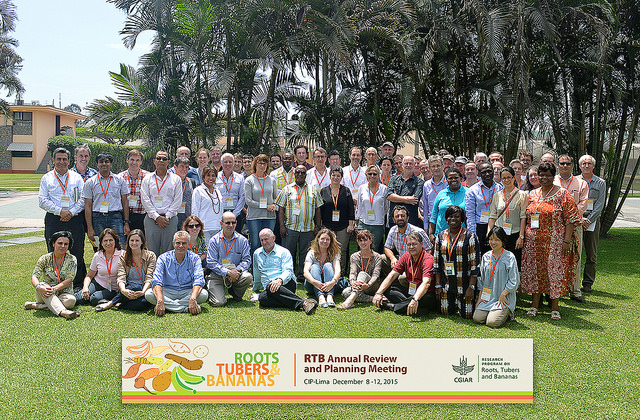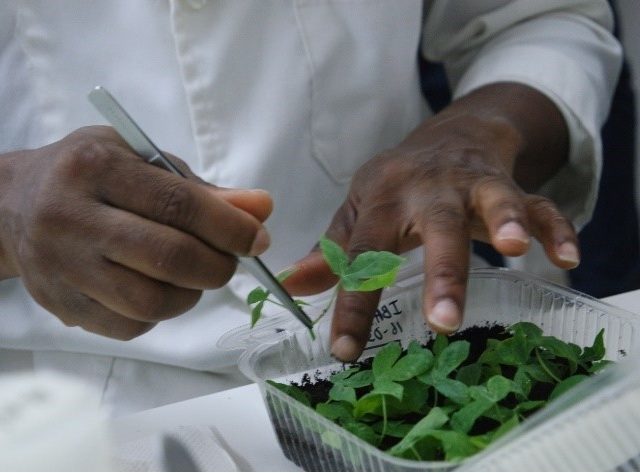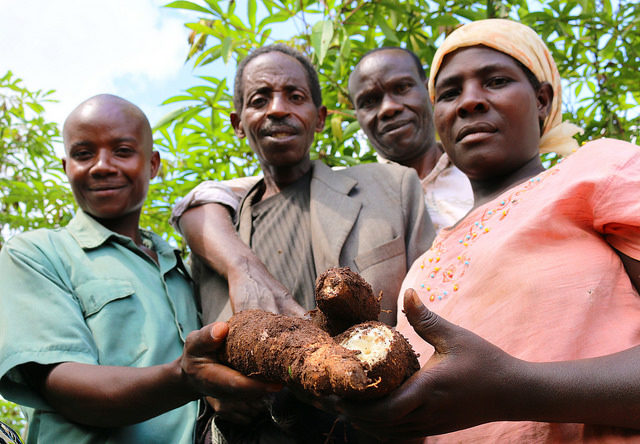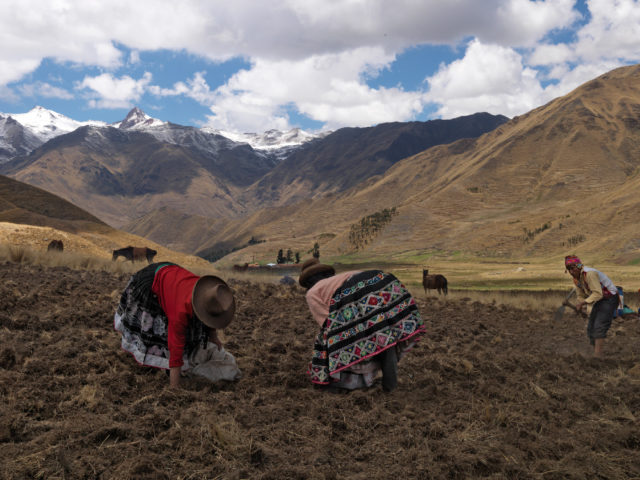The Annual Review and Planning Meeting of the CGIAR Research Program on Roots, Tubers and Bananas (RTB) took place last week from 8 – 10 December, 2015 in Lima, Peru.
The event was hosted by the program’s lead center, the International Potato Center (CIP), and brought together over 50 researchers from the five program partner centers – the International Institute of Tropical Agriculture, Bioversity International, the International Center for Tropical Agriculture, CIRAD and CIP – along with colleagues from other partners including Florida State University and Wageningen University. A representative from a key RTB donor, USAID, also attended the event to share in this year’s highlights.
Over three days, participants reported on highlights and key achievements from the program’s six research themes, which led to enthusiastic and constructive discussion about the results and next steps for the program in 2016. The collegial and dynamic atmosphere set a positive tone for the year ahead as RTB prepares to undergo a significant shift away from research ‘themes’ to ‘flagship projects’ in 2016.
Selected highlights from the Annual Meeting:
Theme 1 – Unlocking the value and use potential of genetic resources
- Through complementary funding, RTB has enabled the application of next generation sequencing to change our understanding of genetic diversity, genetic resource collections and breeding populations of root, tuber and banana crops.
- In several crops, including potato and cassava, we are gaining an understanding of the identity of crop varieties, the status of duplication and misidentifications. This is enabling a much higher level of quality control of information on germplasm and breeding populations to assist with more efficient use of RTB resources.
- Metabolomics has been successfully applied to banana, potato, and yam to identify differences between genotypes and treatments.
- DNA sequencing could separate genepools in cassava based on origin. Sequencing data has proven useful to improve the cassava genome. Further gene characterization raises the question of perhaps using genome editing to reduce cyanide levels in cassava.
- Genome-Wide Association Studies have applied in banana for the first time, and have identified candidate genes for seedlessness.
- A ‘Trait Observation Network’ to close potato yield gaps in Africa and Asia started this year and involves extensive G x E phenotyping for drought, late blight, virus resistance, and maturity of already genotyped breeding panels.
- Shovelomics and other root phenotyping methods to analyze root architecture in relation to drought stress shows potential for screening genotypes at early development stages, as root weight and root dry matter weight is correlated with sweetpotato storage root yields.
Theme 3 – Managing priority pests and diseases
- Results of work on degenerative diseases show that positive selection, which involves visually identifying and selecting only symptomless plants as the seed source for the next generation, can be as effective as the use of clean seed where selection can be done accurately.
- Pest Risk Analysis along an altitude gradient was used as a proxy for climate change, and revealed that some diseases have higher incidence at lower altitude, and some have higher incidence at lower levels. Hence, climate change is expected to have some positive and negative effects.
- Crop land connectivity was used to assess risk for invasion and saturation by pathogens and pests, and showed that the Great Lakes region in East Africa has the highest threat for RTB crops combined.
- An interdisciplinary Banana Bunchy Top Disease Alliance was set up, and practicable models, tools and procedures for containment and recovery were developed.
- Single Diseased Stem Removal has been found to be a very effective and farmer-friendly method for controlling Banana Xanthomonas Wilt.
- A successful Private-Public Partnership has been set up to reduce pesticide use to control Potato Tube Moth through the development of a pheromone-based control strategy that attracts and kills the pest.
Theme 4 – Making available low-cost, high quality planting material for farmers
- A conceptual framework was developed to analyze RTB seed systems, extract lessons and generate recommendations for improving the design and implementation of future interventions.
- Quality Declared Quality Planting Materials as an alternative to formal certification is a lower cost and more feasible opportunity for seed system with RTB crops where seed is typically bulky and/or perishable.
- A key message of the research in this theme was that understanding gender roles in seed systems is critical for positive impact.
- How can positive selection of seed become adopted as more routine practice in improved seed system?
- A framework for understanding availability, access and use of quality seed has been developed and specific research questions have been proposed around this linked to a series of case studies.
At the end of the first day, CIP hosted an Open House afternoon, showcasing the center’s work in areas including a demonstration of remote sensing of a potato field using a drone and in-house software to collect and analyze the data, and an introduction to the Genebank’s collection of in vitro germplasm of potato, sweetpotato and Andean roots and tubers.
Day two of the meeting covered the highlights from Themes 5 and 6:
Theme 5 – Developing tools for more productive, ecologically robust cropping systems
- Developing ability to provide targeted recommendations about the next steps for cropping systems improvement, as a function of a farm’s current status (technology limited, resources limited, decision limited).
- Providing recommendations that can be used by farmers immediately for more robust and profitable cropping systems.
- Support for farmer soil management through careful analysis of nutrient balances shows promise for smallholder banana production.
Theme 6 – Promoting post-harvest technologies, value chains, and market opportunities
- Sensory tasting for cassava should be product specific. For example, Gari can be eaten dry, as a paste, in porridge etc. When you want to evaluate the acceptability of Gari you have to decide on one of the products.
- Much work has gone in to improving drying technologies and there is evidence that some technologies are preferred more than others, such as Cabinet driers in Tanzania.
- Interlinkages with other projects are building on work that has already been done, e.g. RTB-ENDURE project is testing improved clones in development of value chains in Uganda.
- Climate change effects: research has shown that the production of bitter alkaloids in the potato tuber increases with temperature making them unacceptable, this has strong implications for climate change in potato
The meeting concluded with a smaller two-day workshop on 11-12 December to refine the program’s shift away from research ‘themes’ to a new structure based on five ‘flagship projects’ in 2016. More detail about RTB’s new flagship projects will be coming soon.



